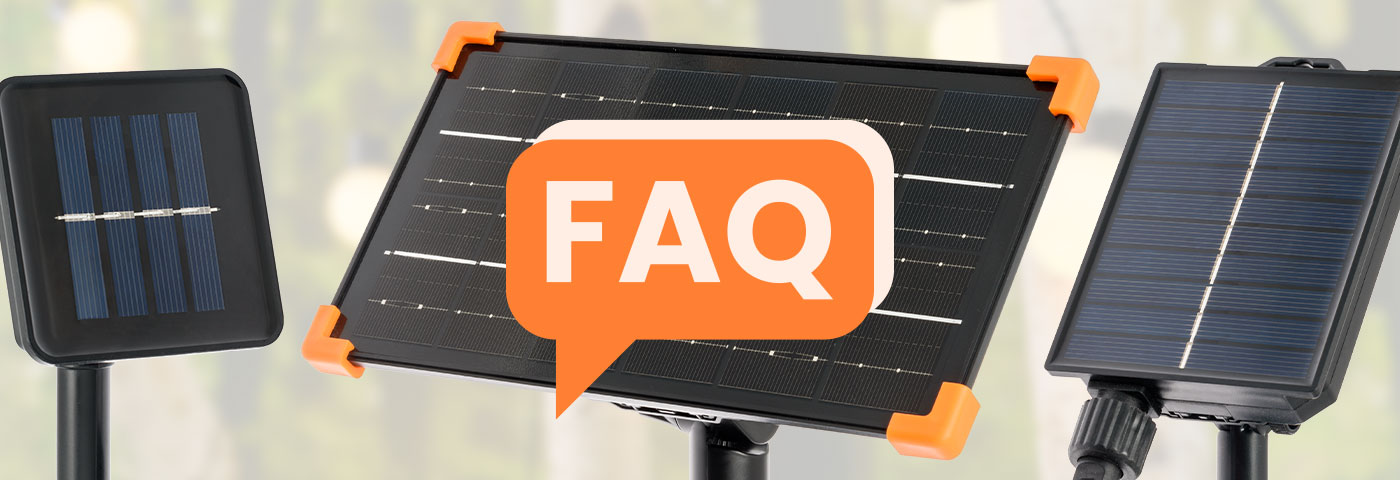All Answers to Questions on Solar Lights
In this article we answer the most common questions on the operation, installation and maintenance of solar lights.

Date
07.06.2023
Reading time
10 min
We receive many questions about the operation of solar lights, their installation, maintenance and how to use them to get the maximum benefit from the use of this decoration solution.
Below you will find answers to some of the most common questions.
Quando preferire le luci solari?
Le luci solari hanno il vantaggio di essere estremamente versatili e semplici da installare. Non richiedono di stendere cavi elettrici, che in alcuni casi possono essere anche pericolosi, dandoti la massima versatilità di posizionamento, ovunque desideri.
Le luci solari sono perfette per decorare gli esterni di case e villette, puoi utilizzarle per illuminare il giardino o abbellire ingressi e vialetti.
Sono la soluzione perfetta quando hai difficoltà di collegamento alla rete elettrica e le vuoi utilizzare prevalentemente durante il periodo estivo.
Considera che le luci solari, così come quelle a batteria, non hanno la stessa capacità di illuminazione delle catene a corrente, quindi opta per queste luci se la tua necessità è prevalentemente quella di decorare i tuoi spazi esterni e non di illuminare.
Le luci solari non sono prodotti professionali, è quindi consigliato l’uso in ambito domestico o per piccoli allestimenti nei locali pubblici.
Come funzionano le luci solari?
Tutte le luci solari, che siano lampade, faretti o lampioni, sono dotate di un pannello solare che cattura l’energia ricevuta durante il giorno e la trasforma in elettricità. L’energia viene accumulata da una batteria per alimentare il funzionamento delle luci durante la notte.
Oltre a ricaricare la batteria, il pannello solare regola l’accensione automatica delle luci al tramonto e il loro spegnimento al sorgere del sole.
How long does it take to recharge solar lights?
The charging time of solar lights is a function of several factors:
- Amount of sun exposure during the day;
- Panel type: size and thus battery charging power;
- Battery type: size, battery chemistry and level of wear;
- Initial charge level.
On average, you can keep the solar panel exposed between 5 and 8 hours, during the summer period, before getting a full charge.
At first use, we recommend extending this exposure period by 50% or 100%.
Can I use solar lights during winter?
Solar lights recharge when the sun is shining, so in theory they can be used in winter. In practice, however, the limited sun exposure at that time can prevent the battery from being fully recharged, resulting in low brightness and a short battery life.
We therefore advise you to consider purchasing solar lights for a predominant use during the summer period.
Le luci solari necessitano proprio del sole per ricaricarsi?
Il pannello solare riesce a raggiungere il massimo delle sue performance solo se irradiato dalla luce solare diretta. Se questo viene illuminato da una luce artificiale o dalla luce solare filtrata ad esempio da un vetro, l’efficienza nella ricarica è limitata.
Il pannello deve essere posizionato e orientato in un luogo dove riceve il massimo della luce solare durante il giorno. A questo proposito è necessario prestare attenzione ad eventuali ostacoli, come alberi o arbusti che potrebbero ombreggiare durante il giorno il pannello e quindi ostacolarne la piena ricarica.
Come ricaricare le luci solari senza il sole?
Nel nostro catalogo troverai alcune luci solari da giardino che hanno in dotazione un pannello solare con ricarica USB. In questo modo, se durante il giorno c’è stata poca esposizione solare, potrai velocemente ricaricare la batteria integrata attraverso un comune alimentatore per smartphone.
What maintenance is required for solar lights?
Solar lights are convenient because, once installed, you can forget you have them. Thanks to the light sensor, they switch on and off automatically.
However, if you want to keep your solar lights efficient and long-lived, you need to provide these quick and easy tasks:
- Clean the panel regularly with a damp cloth: even the formation of a layer of dust negatively affects the panel's ability to produce energy;
- Check for possible shading of the panel during the day: after positioning the panel, check whether during the day the presence of shrubs or plants prevents the panel from receiving maximum sunlight. Then consider changing the position of the panel, its orientation or the removal of shading objects;
- Switch off the decoration if you are not using it: if you do not need the solar lights for a while, use the ON/OFF button to switch off the light sensor. This will prevent them from switching on in the evening and unnecessarily discharging the battery. Remember that batteries always have a certain number of charging cycles before they lose their efficiency.
Posso utilizzare le luci solari tutto l’anno?
Le luci solari da esterno possono essere tecnicamente utilizzate tutto l’anno ma in alcuni periodi, come durante l’inverno, l’esposizione solare è limitata e la batteria potrebbe non ricaricarsi completamente.
Se vuoi illuminare il tuo giardino con luci e lampade solari anche durante i mesi più freddi ti consigliamo di preferire luci che hanno più alternative di ricarica.
Nel nostro catalogo hai due possibilità tra cui scegliere:
- Luci solari con ricarica anche via USB: in questo modo puoi ricaricare la batteria integrata con la rete elettrica e un semplice alimentatore per smartphone;
- Luci solari Smart Connect con multi alimentazione: questa serie di luci può essere alimentata, oltre che dal pannello solare, anche da un portabatterie tradizionale o da un trasformatore di corrente. Questo ti darà la massima flessibilità di utilizzo in tutte le condizioni.
Considera comunque che la batteria integrata ha un certo numero di ricariche, quindi ti consigliamo di non lasciare la decorazione accesa anche quando, durante l'anno, non è necessario.
How to install solar lights?
Solar lights are great because they create a cosy atmosphere and at the same time bring many advantages:
- Cheap and environmentally friendly: due to the lack of energy consumption, they produce no harmful emissions;
- Safe: thanks to low operating voltage;
- User-friendly and simple: thanks to the fact that they can be installed wherever you want, regardless of the proximity of electrical sockets.
However, there are a few simple tricks that will help you get the most out of your solar installation:
- Position and orient the solar panel so that it has maximum direct solar radiation throughout the day;
- Pay attention to any obstacles that may block sunlight during the day: shrubs, trees or shadows from buildings or shelters;
- Do not install solar lights near street lights or other light sources: all solar lights have a built-in light sensor on the panel that only activates the lights when it is dark. If other ambient lights irradiate the panel during the night, the lights will not turn on;
- Make the solar panel easily accessible for regular cleaning: dust or dirt is an obstacle to battery charging;
- Avoid placing lights and the solar panel within reach of the lawn irrigation jets.
Qual’è la durata di funzionamento delle luci solari?
La durata di funzionamento delle luci solari è naturalmente in funzione della quantità di energia accumulata dalla batteria interna durante il giorno, ma non solo. Possiamo fornire alcuni suggerimenti, soprattutto legati all’uso, per ottenere il massimo dalla tua decorazione solare.
La durata di una luce solare è di circa 6-8 ore con una carica completa della batteria.
Oltre a tenere presente i consigli sopra indicati sull’installazione e manutenzione delle luci, l’aspetto principale è evitare che le batterie si continuino a scaricare anche quando non serve.
Proprio per evitare che questo succeda, ecco alcuni accorgimenti d’uso:
- Utilizza uno degli effetti luminosi preimpostati: la luce fissa è la modalità di funzionamento più energivora perchè tutti i led sono costantemente accesi, ma se scegli un gioco di luce avrai un dispendio inferiore di energia;
- Utilizza il pulsante ON/OFF per accendere le luci quando ti servono: le batterie, man mano che si susseguono i cicli di carica e scarica, perdono di efficienza. Evitare quindi di ricaricare inutilmente la batteria anche quando non serve ti aiuterà a mantenerla più efficiente;
- Utilizza la funzione timer: grazie al sensore di luminosità, che è sempre presente, la decorazione si accende automaticamente la sera ma rimane accesa tutta la notte, anche quando non ti serve. Il timer ti consente di spegnerla dopo 3, 5 o 8 ore di funzionamento, preservando così la carica della batteria, che necessiterà di meno tempo il giorno successivo per arrivare alla carica completa.
If you still have doubts, we invite you to contact us, or, if you want to learn more about how solar lights work, you can read our complete guide to solar lights.
Index
- Introduction
- When should solar lights be preferred?
- How long does it take to recharge solar lights?
- Can I use solar lights during winter?
- Do solar lights need the sun to recharge?
- What maintenance is required for solar lights?
- Can I use solar lights all year round?
- How to install solar lights?
- What is the service life of solar lights?



